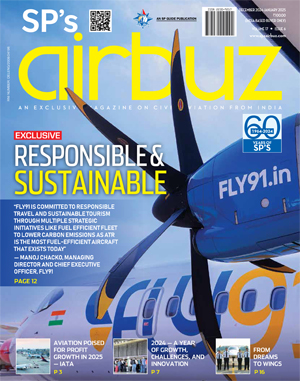Saga of Success

Brazilian coffee and soccer have swept people across the world. That is not all. In the global aviation scenario, Brazil through Embraer has captured the imagination of the world with its products in commercial, executive and military segments, to become the third largest of the jet makers, just behind the biggies Airbus and Boeing. And Forbes has ranked the aerospace and defence major Embraer at 1517 in the Forbes Global 2000 companies. Embraer has reached such great heights and is still going strong, thanks first to the Brazilian Government for the initiatives it took in the teething stages and subsequently to the private enterprise which has been upfront when it comes to innovation, product development and delivery.
Brazilian coffee and soccer have swept people across the world. That is not all. In the global aviation scenario, Brazil through Embraer has captured the imagination of the world with its products in commercial, executive and military segments, to become the third largest of the jet makers, just behind the biggies Airbus and Boeing. And Forbes has ranked the aerospace and defence major Embraer at 1517 in the Forbes Global 2000 companies. Embraer has reached such great heights and is still going strong, thanks first to the Brazilian Government for the initiatives it took in the teething stages and subsequently to the private enterprise which has been upfront when it comes to innovation, product development and delivery.
The company which has three distinct operations—commercial aviation; defence and security; and executive aviation—has been able to make noteworthy strides in each of the segments. It has produced more than 5,000 aircraft that operate in 80 countries of five continents, and it is the market leader for commercial jets with up to 120 seats. As of May 2013, it had a market capitalisation of $6.27 billion. The commercial aviation segment is involved in the development, production and sale of commercial jets, as well as in the provision of support services, with emphasis on the regional aviation industry and aircraft leasing. Embraer has over the years achieved enormous technological and industrial capabilities. Commercial aviation accounted for 61 per cent of Embraer’s revenues last year, followed by 21 per cent for business aircraft and 17 per cent for defence products.
The entry into service of the new Embraer 170/190 family of commercial aviation in 2004 confirmed Embraer’s definitive presence in the aviation market with the launch of new products, as well as the expansion of its operations into the aviation services market, and also established solid foundations for the future development of the company. It has been making history at regular intervals, the latest being the E-Jets touching the 1,000 mark and the overall aircraft deliveries totalling 5,087, as of September 2013. By December 2012, the Embraer family of 170/190 had firm orders for 1,093 with 580 options, of which it has touched 1,000 deliveries. E-Jets revolutionised air travel by unlocking the potential of the 70- to 130-seat segment and its proven success as the world’s most preferred aircraft in the category is built around endearing family traits: versatility to match capacity with market demand by delivering range, economy, and a superior passenger experience. Added to these features is a robust global service network.
The President and CEO Frederico Curado is optimistic that the company will notch up lot more orders in the coming years as airlines see the benefit of right-sizing aircraft. He said the company expected to deliver 90-95 E-Jets this year, a similar number in 2014. It has bagged 281 firm E-Jet orders in 2013, including 150 for its new ‘E2s’ (second-generation).
Embraer airplanes are with over 90 customers worldwide, proving that the jets produced by Embraer have established themselves as essential tools for the development of aviation, worldwide. The 70- to 120-seat E-Jets have a strategic function in airline companies, helping them to maintain their competitive edge. With the first-generation of E-Jets having a formidable presence in the marketplace, Embraer is now launching the E2s. The second-generation promises even higher achievement than the first, promising 16-23 per cent improvements in fuel burn and 15 per cent lower maintenance costs. The E2 is expected to enter service between 2018 and 2020.
There has been encouraging demand for E-Jets, but according to Curado, the company expects E-Jet production rates to remain at about eight per month through next year. Europe accounted for 31 per cent of overall sales in 2012, followed by North America at 25 per cent. Brazil and China were sharing third place with 14 per cent each. Curado expects North America to regain its top spot in the next two years when airlines pick E175s which are mainly used as hub feeders.
Analyst Derek Spronck of RBC Capital Markets has stated that Embraer’s market share between 2013 and 2015 will increase to 63 per cent from the aggregate 54 per cent it achieved between 2001 and 2012. He said Embraer benefits from an installed base of 1,800 planes over 60 customers and its recent announcement to revamp its line of products. Embraer’s backlog now is at a point where he anticipates a 17 per cent ramp up in deliveries in 2014, adding $425 million in extra revenue. Montreal-based Bombardier used to dominate the regional jet market but has seen its leadership dwindle since Embraer introduced its E-Jet family in 2004. While the two rivals have historically accounted for about 95 per cent of the regional jet market, they are expected to face competition in the coming years from new arrivals, including Japan’s Mitsubishi Regional Jet (MRJ), Russia’s Sukhoi (Superjet) and Comac of China.
Brazil’s enormous strides made in the aerospace sector have become an example for other developing nations, particularly India which is still toying with the idea of a regional transport aircraft.





